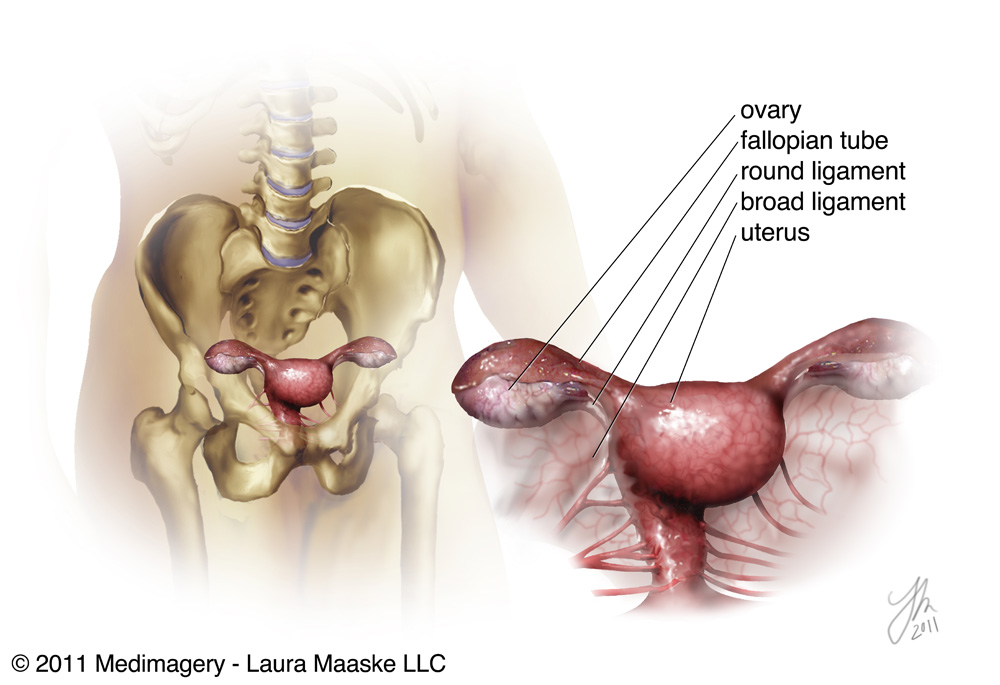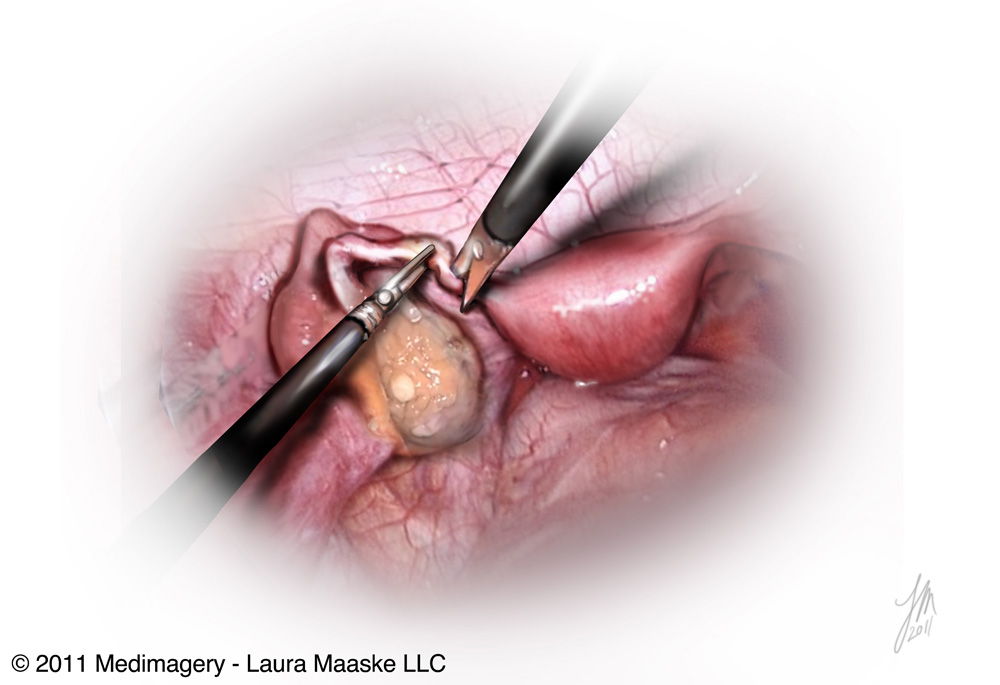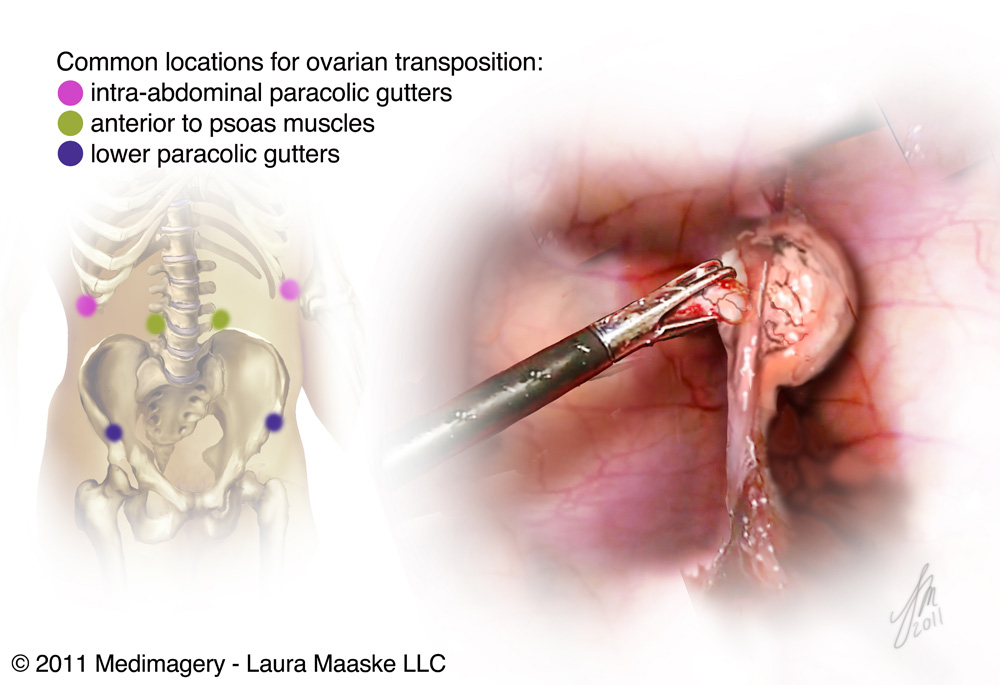
An Illustrated Ovarian Transposition: Oophoropexy
Medical Illustration Series: Ovary
Written and illustrated by Laura Maaske, MSc.BMC, Medical Illustrator & Medical Animator
What is this surgery?
The purpose of this procedure is to relocate the ovary in order to preserve fertility for patients with various conditions including cancer. If a tumor is found near a woman’s ovary, her ovary may be moved to a different part of her abdomen so that radiation can be safely performed in the position where the ovary had naturally been. Later in her life, the surgeon may move the ovary back to its proper position, giving the woman a better chance to become pregnant.
This series is in particular one of my favorite surgical illustration projects, as I learned preparing it than almost any other surgical drawings in my career. Before this time I tended to be very ideal about anatomy. I wanted the anatomical scene to appear as it would in a “perfect” condition. However, the reality is that the surgical field changes throughout the course of a procedure. I began to pay attention to the tissues themselves. It is an interesting progression, an internal contradiction or paradox, that just as the surgeon is making repairs and increasing the health of the body in the actions taken with instruments, the body is also temporarily being broken down and tissues will have to begin their own process of repair as the surgery comes to an end.
History of the ovarian transposition procedure
Oophoropexy or Ovarian Transposition is a procedure developed beginning in 1958 for patients at risk of radiotherapy-induced damage to their ovaries due to radiation of their pelvic region. Reasons for such radiation might include Hodgkin’s disease, cervical cancer, pediatric spinal radiation, rectal cancer, and other gynecologic malignancies. The success rate for the procedure is mostly unknown as the procedure is still fairly new, but ranges between 16-90% (Reproductive Endocrinology and Infertility: Integrating Modern Clinical and Laboratory Practice Douglas T. Carrell; Springer, 2010; p. page 709).
During the surgery, the ovaries are moved outside of the “radiation portal”, or region which would be affected by radiotherapy.
The series highlights major events in the ovarian transposition procedure.
1. Overview of the oophoropexy procedure: the relevant anatomy
2. Releasing the ovary
3. Repositioning the ovary
There are three common relocation position in the abdomen for the ovary. Depending upon the location of the tumor, and where radiation will be directed, the tumor may be placed in any of these locations, on the right or left side of the abdomen.
4. Securing the ovary in its new position
Interestingly, there is some risk, though very small, of the ovaries migrating to their original positions.
Further Resources
See: Laparoscopic Ovarian Transposition to Preserve Ovarian Function Before Pelvic Radiation and Chemotherapy in a Young Patient With Rectal Cancer Leonard A Farber, MD, John W Ames, MD, Stephen Rush, MD, and David Gal, MD Posted: 03/16/2005; Medscape General Medicine. 2005;7(1):66 © 2005 Medscape
See:
Cancer and Pregnancy by Antonella Surbone, Fedro Peccatori, Nicholas Pavlidis; Springer, 2008 – Health & Fitness; page 2004
See:
Ovarian Transposition pp. 250-256
Carrie A. Smith, Erin Rohde and Giuseppe Del Priore
See:
Principles and Practice of Fertility Preservation
Donnez, Jacques; and Kim, S. Samuel.
Cambridge University Press, 2011. Cambridge Books Online. Cambridge University Press.
Suggested Tweets:
“Why would a woman want to have her ovary moved?”
If you would like a quote on a medical, surgical, or scientific illustration project, contact Laura Maaske with any questions you might have.
_________________________________
Laura Maaske, MSc.BMC.
Biomedical Communicator
Medical Illustrator
Medical Animator
Health App Designer
[jp_post_view]







